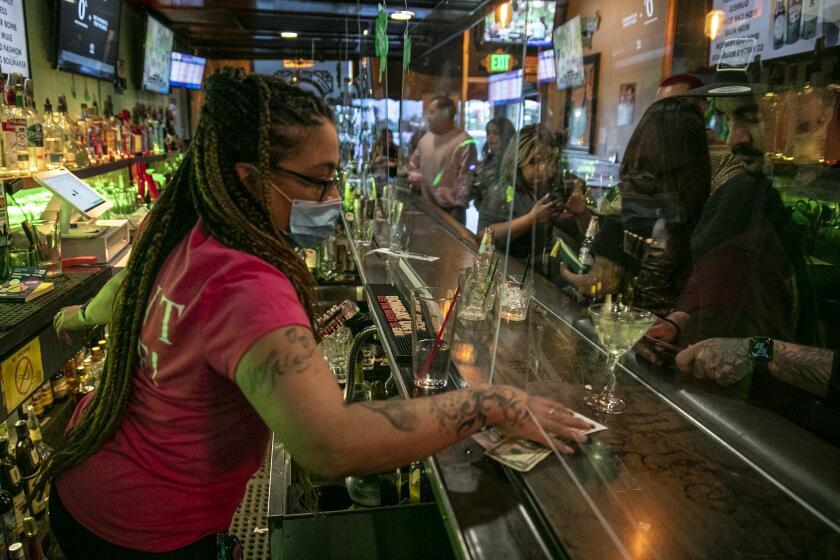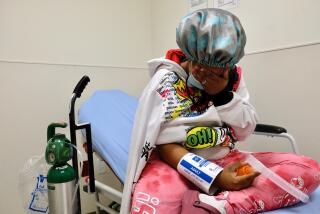California enters a perilous phase as coronavirus spread intensifies

- Share via
California plummeted deeper into a new coronavirus crisis Monday as new cases spiked to record levels, some hospitals filled up, and officials expressed growing alarm and frustration with people refusing to follow safety rules despite the increasingly perilous conditions.
The state broke its record Monday for the greatest number of new coronavirus cases reported in a single day, tallying more than 8,000. That’s the third time in eight days the state has broken a record of new daily cases, according to the Los Angeles Times’ California coronavirus tracker.
A Times analysis found that California is on track to roughly double the number of coronavirus cases in June over those it recorded in May. In May, there were 61,666 cases reported statewide; by Monday night, there were 114,196 cases reported for the first 28 days of June.
By Monday evening, there were a cumulative reported 223,000 confirmed cases and more than 5,900 coronavirus-related deaths in California.
The coronavirus has rapidly spread through communities as the economy has reopened and people reverted to old behaviors, returning to bars, barbecues and birthday parties. The new data show “alarming increases in cases, positivity rates and hospitalization,” L.A. County Public Health Director Barbara Ferrer said.
Los Angeles County, long the center of coronavirus in California, hit another grim milestone, surpassing 100,000 confirmed cumulative cases and more than 3,330 deaths. The county reported more than 3,000 new COVID-19 cases on Monday alone, also recording its largest single-day number of new infections, according to The Times’ coronavirus tracker.
Gov. Gavin Newsom said the state is prepared to reinstate restrictions of his stay-at-home order as cases of the coronavirus continue to increase in California.
The number of hospitalizations of confirmed COVID-19 patients has also soared in L.A. County, rising by 44% in the past two weeks. On Sunday, 1,732 COVID-19 patients were hospitalized, up from 1,206 two weeks earlier.
L.A. County is now projecting the possibility of running out of its existing supply of hospital beds for COVID-19 patients in two to three weeks. Likewise, the number of intensive-care beds available could be exhausted sometime in July. Hospitals can, however, make more room for coronavirus patients by canceling elective surgeries and making other moves to increase capacity.
“This is the time to hunker down back in your home whenever you can,” Ferrer said, urging people to wear face coverings and practice social distancing. “Please, let’s not let go of everything we worked hard and sacrificed for.”
She urged people to avoid crowds: “It’s just not safe right now.”
The L.A. County Department of Public Health also announced a ban on fireworks displays.
Ferrer said the surge is proof — “definitively” — that community transmission has increased, with the cumulative rate of those testing positive for infection increasing from 8% to 9%. Officials are now warning that 1 in 140 residents are probably unknowingly infected with the virus and contagious to others, a threefold increase over last week’s projection of 1 in 400.
That means a typical large, busy store would probably have multiple infectious persons enter and shop every day, officials said.
In addition, health officials revealed that on the weekend after June 19 — the day Los Angeles County gave the green light for bars, breweries, wineries and similar businesses to reopen — more than 500,000 people visited the county’s newly reopened nightlife spots.
Inspectors, however, found over the weekend that employees at about half of bars and restaurants were not wearing face masks or shields. Half of bars and one-third of restaurants were not adhering to social distancing protocols. Gov. Gavin Newsom ordered bars in L.A. County and four other counties in the San Joaquin Valley closed Sunday because of the increasing case numbers.
The effective transmission rate of the coronavirus has now increased across the county. Previously, through the beginning of May, for every one person infected, fewer than one other person on average was infected — a testament to the success of the stay-at-home order. But by early June, as the reopening accelerated, the coronavirus transmission rate had crept above 1, meaning for every one person infected, an additional 1.26 people are infected on average.
Orange County confirmed 57 coronavirus-related deaths for the seven-day period that ended Sunday, the highest weekly death toll that the county has reported since the pandemic began in the U.S. It was the third consecutive week Orange County broke a weekly record for COVID-19 deaths.
There are now 19 counties on the state’s coronavirus watch list, including L.A., Orange, Riverside, San Bernardino and Ventura counties.
Officials are growing increasingly alarmed by the upcoming Fourth of July weekend because they fear more crowds and gatherings could spread COVID-19 further.
Los Angeles County will close its beaches Friday and ban fireworks displays in anticipation of the holiday.
All public beaches, piers, public beach parking lots, beach bike paths “that traverse that sanded portion of the beach” and beach access points will be closed from 12:01 a.m. Friday to 5 a.m. Monday. The ban on fireworks displays applies to the long Fourth of July weekend.
Times staff writer Ryan Murphy contributed to this report.
More to Read
Sign up for Essential California
The most important California stories and recommendations in your inbox every morning.
You may occasionally receive promotional content from the Los Angeles Times.















